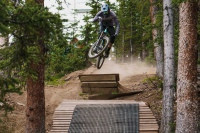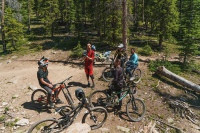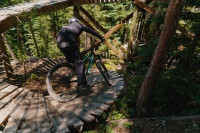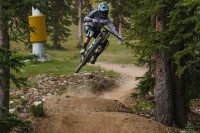Keystone, Colorado, nestled in the heart of the Rockies, boasts a rich history in outdoor recreation. For mountain bikers, Keystone Bike Park is a major draw, promising 55 miles of lift-accessed trails characterized by steep and technical terrain. Our crew was buzzing with anticipation as we headed south through the Rocky Mountain State, eager to explore what Keystone Bike Park had to offer. The base village is undeniably charming, providing a range of hotels, dining, and shopping, making it an attractive destination. It’s also a family-friendly resort, with activities for kids both in the village and on the mountain, complemented by numerous local attractions nearby, including stunning lakes and mountain vistas. However, despite these positives, Keystone Bike Park unfortunately has some areas that fall short, which we will delve into below. This is particularly disappointing given the overall appeal of Keystone as a resort. Let’s see how Keystone Bike Park compares to other bike parks we’ve visited.
 Riders navigating a berm on a Keystone Bike Park trail
Riders navigating a berm on a Keystone Bike Park trail
Trail Experience at Keystone Bike Park
Let’s get right to the heart of it: the trails at Keystone Bike Park. The mountain is predominantly geared towards advanced riders. While a green trail exists, it’s likely the only option truly suitable for beginners. This is largely due to the trail design, layout, and, crucially, maintenance – or rather, the lack of consistent upkeep. Keystone Bike Park is set on a large mountain, resulting in very long trails. If a rider finds themselves on a trail beyond their skill level, they’re in for a lengthy and potentially challenging descent.
Starting with the beginner options, it quickly became clear that there isn’t much for genuinely novice riders at Keystone Bike Park. There’s a single, extended green trail that serves as a stepping stone to more challenging terrain, leading to trails rated blue that we found to be some of the most technically demanding blues of our entire trip. Trails like “Eye of the Tiger” and “Mosquito Coast” are undeniably fun but lean towards the upper end of the blue difficulty spectrum. These scenic singletracks are packed with roots, rocks, and sharp turns, demanding constant attention even when carrying speed. We thoroughly enjoyed lapping these trails, constantly finding new lines to increase speed and corner more aggressively. However, true beginners might find these trails quite intimidating. They definitely fall into the dark blue category and represent a significant jump in difficulty from the green trail.
 A rider conquers a rocky section of trail at Keystone Bike Park
A rider conquers a rocky section of trail at Keystone Bike Park
Steep and technical trails are the defining characteristic of Keystone Bike Park, although there are efforts being made to develop jump lines. It’s undoubtedly a challenging mountain, especially during the dry summer months when the steep, rocky terrain becomes exceptionally loose. Trails branch out in various directions from the summit, providing ample opportunity to test your line choice and keep you engaged for hours.
The black and double black technical trails range from downhill race-style tracks to rugged, almost unrideable rock chutes that often led to a game of “Rock, Paper, Scissors” to decide who would attempt them first. The ruggedness of the mountain extends to the trail signage, which can sometimes be unclear. With a small trail crew of only four full-time workers, it’s not surprising that a steep and rocky mountain like Keystone Bike Park faces maintenance challenges. Many areas suffer from deep ruts, blown-out corners, and awkward lines. We came to realize that Keystone Bike Park is somewhat of a “Local’s Mountain.” Riders who frequent the park and call it their home spot likely have a strong attachment to it, while newcomers accustomed to more manicured bike parks might need a significant adjustment period. It’s definitely a park for riders who thrive on picking lines through rocky terrain and tackling technical features.
 A rider navigates a steep, bermed corner at Keystone Bike Park
A rider navigates a steep, bermed corner at Keystone Bike Park
 A rider catches air on a jump at Keystone Bike Park
A rider catches air on a jump at Keystone Bike Park
 A scenic view from a Keystone Bike Park trail
A scenic view from a Keystone Bike Park trail
 A rider descending a steep and rocky section at Keystone Bike Park
A rider descending a steep and rocky section at Keystone Bike Park
 Another view of a rider on a technical trail at Keystone Bike Park
Another view of a rider on a technical trail at Keystone Bike Park
 A rider approaches a jump on a Keystone Bike Park trail
A rider approaches a jump on a Keystone Bike Park trail
For riders who aren’t primarily seeking raw, natural trails, Keystone Bike Park has less to offer. The jump trails, like “TNT,” were a letdown in our opinion. The layout felt subpar, suffering from poor speed management or steep gradients that necessitate heavy braking between jumps. Consequently, this trail exhibited the most severe braking bumps and holes of any bike park we visited that summer. Landings were also often covered in loose, eroded rock. “Money,” another jump trail, showed significant improvement in terms of gradient and layout. However, substantial inconsistencies in jump sizes and steep, awkwardly shaped lips made the trail challenging and even somewhat risky to ride, even for experienced riders. Part of the issue at Keystone Bike Park is the limited trail crew. While the team is undoubtedly hardworking, maintaining 55 miles of bike park trails with fewer than five people is a monumental, if not impossible, task. A local rider we met on the trails explained that there’s a distinction between “trail speed” and “Keystone speed.” Trail speed refers to the intended speed at which most good trail builders design features, ensuring that riders carrying the natural speed of the trail are properly set up for jumps, step-downs, and drops. At Keystone Bike Park, we frequently found ourselves launching off jumps or cannon logs only to see the landing disappear behind us as we braced for a harsh, flat landing. Conversely, after navigating several smaller jumps with perfect speed, we’d encounter a lip leading to a jump that was far too long for the speed we were carrying.
Conclusion
Keystone Bike Park presents a unique riding experience deeply rooted in its natural, rugged mountain terrain. It excels in offering challenging, technical trails that will appeal to advanced and expert mountain bikers seeking raw, natural riding. However, the park struggles with maintenance across its extensive trail network, and the jump trails are inconsistent in quality and design. While Keystone Bike Park may not be ideal for beginners or riders primarily focused on flow and jump trails, it holds a certain charm for those who appreciate the challenge of steep, technical descents and natural, unmanicured trails. Experienced riders looking for a true Rocky Mountain test will find something to love at Keystone Bike Park, particularly if they appreciate the “local’s mountain” vibe and are prepared for a raw and demanding riding experience.
